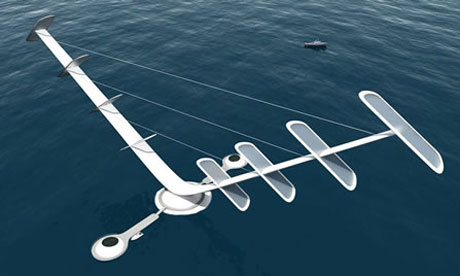Solar Grand Plan
 Ken Zweibel, James Mason and Vasilis Fthenakis lay out their Solar Grand Plan in Scientific American.
Ken Zweibel, James Mason and Vasilis Fthenakis lay out their Solar Grand Plan in Scientific American.
On the following pages we present a grand plan that could provide 69 percent of the U.S.’s electricity and 35 percent of its total energy (which includes transportation) with solar power by 2050. We project that this energy could be sold to consumers at rates equivalent to today’s rates for conventional power sources, about five cents per kilowatt-hour (kWh). If wind, biomass and geothermal sources were also developed, renewable energy could provide 100 percent of the nation’s electricity and 90 percent of its energy by 2100.
Under these assumptions, U.S. energy demand could be fulfilled with the following capacities: 2.9 terawatts (TW) of photovoltaic power going directly to the grid and another 7.5 TW dedicated to compressed-air storage; 2.3 TW of concentrated solar power plants; and 1.3 TW of distributed photovoltaic installations. Supply would be rounded out with 1 TW of wind farms, 0.2 TW of geothermal power plants and 0.25 TW of biomass-based production for fuels. The model includes 0.5 TW of geothermal heat pumps for direct building heating and cooling. The solar systems would require 165,000 square miles of land, still less than the suitable available area in the Southwest.
Solar plants consume little or no fuel, saving billions of dollars year after year. The infrastructure would displace 300 large coal-fired power plants and 300 more large natural gas plants and all the fuels they consume. The plan would effectively eliminate all imported oil, fundamentally cutting U.S. trade deficits and easing political tension in the Middle East and elsewhere. Because solar technologies are almost pollution-free, the plan would also reduce greenhouse gas emissions from power plants by 1.7 billion tons a year, and another 1.9 billion tons from gasoline vehicles would be displaced by plug-in hybrids refueled by the solar power grid. In 2050 U.S. carbon dioxide emissions would be 62 percent below 2005 levels, putting a major brake on global warming.
What kind of technology advances are required?
In the past few years the cost to produce photovoltaic cells and modules has dropped significantly, opening the way for large-scale deployment. To provide electricity at six cents per kWh by 2020, cadmium telluride modules would have to convert electricity with 14 percent efficiency, and systems would have to be installed at $1.20 per watt of capacity. Current modules have 10 percent efficiency and an installed system cost of about $4 per watt. Progress is clearly needed, but the technology is advancing quickly; commercial efficiencies have risen from 9 to 10 percent in the past 12 months.The assumptions for improvements in solar technology and the reductions in cost seem reasonable, maybe even a little understated as they are assumed to end in 2020.
The main progress required, then, is to raise module efficiency to 14 percent. Although the efficiencies of commercial modules will never reach those of solar cells in the laboratory, cadmium telluride cells at the National Renewable Energy Laboratory are now up to 16.5 percent and rising. At least one manufacturer, First Solar in Perrysburg, Ohio, increased module efficiency from 6 to 10 percent from 2005 to 2007 and is reaching for 11.5 percent by 2010.
How much land is needed?
In our plan, by 2050 photovoltaic technology would provide almost 3,000 gigawatts (GW), or billions of watts, of power. Some 30,000 square miles of photovoltaic arrays would have to be erected. Although this area may sound enormous, installations already in place indicate that the land required for each gigawatt-hour of solar energy produced in the Southwest is less than that needed for a coal-powered plant when factoring in land for coal mining. Studies by the National Renewable Energy Laboratory in Golden, Colo., show that more than enough land in the Southwest is available without requiring use of environmentally sensitive areas, population centers or difficult terrain.How is energy stored for when the sun isn't shining?
To meet the 2050 projection, 46,000 square miles of land would be needed for photovoltaic and concentrated solar power installations. That area is large, and yet it covers just 19 percent of the suitable Southwest land.
Compressed-air energy storage has emerged as a successful alternative. Electricity from photovoltaic plants compresses air and pumps it into vacant underground caverns, abandoned mines, aquifers and depleted natural gas wells. The pressurized air is released on demand to turn a turbine that generates electricity, aided by burning small amounts of natural gas. Compressed-air energy storage plants have been operating reliably in Huntorf, Germany, since 1978 and in McIntosh, Ala., since 1991. The turbines burn only 40 percent of the natural gas they would if they were fueled by natural gas alone, and better heat recovery technology would lower that figure to 30 percent.I haven not hear of using compressed air energy storage on such a large scale before, but it is intriguing and I think it could work. 3 to 4¢ per kWh is a bit expensive though for it to go mainstream. I wonder if advances in battery technologies might make them the cheaper and more preferable solution.
Studies by the Electric Power Research Institute in Palo Alto, Calif., indicate that the cost of compressed-air energy storage today is about half that of lead-acid batteries. The research indicates that these facilities would add three or four cents per kWh to photovoltaic generation, bringing the total 2020 cost to eight or nine cents per kWh.
Another technology that would supply perhaps one fifth of the solar energy in our vision is known as concentrated solar power. For energy storage, the pipes run into a large, insulated tank filled with molten salt, which retains heat efficiently. Heat is extracted at night, creating steam. The molten salt does slowly cool, however, so the energy stored must be tapped within a day.
How would the electricity be transmitted from the southwest to the rest of the country?
The existing system of alternating-current (AC) power lines is not robust enough to carry power from these centers to consumers everywhere and would lose too much energy over long hauls. A new high-voltage, direct-current (HVDC) power transmission backbone would have to be built.How much money is needed to make this work and how could that money be collected?
Studies by Oak Ridge National Laboratory indicate that long-distance HVDC lines lose far less energy than AC lines do over equivalent spans. The backbone would radiate from the Southwest toward the nation’s borders. The lines would terminate at converter stations where the power would be switched to AC and sent along existing regional transmission lines that supply customers.
The AC system is also simply out of capacity, leading to noted shortages in California and other regions; DC lines are cheaper to build and require less land area than equivalent AC lines. About 500 miles of HVDC lines operate in the U.S. today and have proved reliable and efficient.
Electricity from photovoltaic farms in the Southwest would be sent over high-voltage DC transmission lines to compressed-air storage facilities throughout the country, where turbines would generate electricity year-round. The key is to find adequate sites. Mapping by the natural gas industry and the Electric Power Research Institute shows that suitable geologic formations exist in 75 percent of the country, often close to metropolitan areas. Indeed, a compressed-air energy storage system would look similar to the U.S. natural gas storage system. The industry stores eight trillion cubic feet of gas in 400 underground reservoirs. By 2050 our plan would require 535 billion cubic feet of storage, with air pressurized at 1,100 pounds per square inch.
The federal government would have to invest more than $400 billion over the next 40 years to complete the 2050 plan. That investment is substantial, but the payoff is greater. Solar plants consume little or no fuel, saving billions of dollars year after year. The infrastructure would displace 300 large coal-fired power plants and 300 more large natural gas plants and all the fuels they consume. The plan would effectively eliminate all imported oil, fundamentally cutting U.S. trade deficits and easing political tension in the Middle East and elsewhere. Because solar technologies are almost pollution-free, the plan would also reduce greenhouse gas emissions from power plants by 1.7 billion tons a year, and another 1.9 billion tons from gasoline vehicles would be displaced by plug-in hybrids refueled by the solar power grid. In 2050 U.S. carbon dioxide emissions would be 62 percent below 2005 levels, putting a major brake on global warming.It is not clear to me how the $400 billion number was calculated, or how reducing it to $100 billion or increasing it to $800 billion would impact the speed at which the plan could be implemented. I wonder if this whole plan could be accomplished without any subsidies if it were pushed back, say, 30 years. If so, the question becomes how much can you push the time frame forward for how much money?
The $420 billion could be generated with a carbon tax of 0.5 cent per kWh. Given that electricity today generally sells for six to 10 cents per kWh, adding 0.5 cent per kWh seems reasonable.
What needs to happen now to get this plan started?
Building 1.5 GW of photovoltaics and 1.5 GW of concentrated solar power annually in the first five years would stimulate many manufacturers to scale up. In the next five years, annual construction would rise to 5 GW apiece, helping firms optimize production lines. As a result, solar electricity would fall toward six cents per kWh.Overall, I find this plan plausible and a good road map of how to get completely off of fossil fuels by 2100 and a significant chunk of that completed by 2050.































